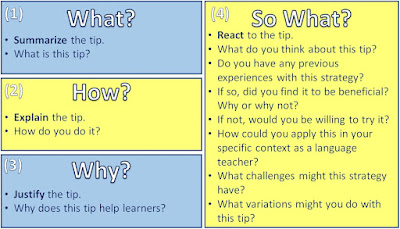Teaching Grammar - Week 5 - Grammar Teaching Techniques
Introduction: Hello and welcome to Week 5 of the course Teaching Grammar for the Licenciatura in English Teaching at ULACIT. In this class we will do several activities to explore and evaluate specific techniques for teaching grammar including analyzing a sample grammar lesson, sharing our reading reactions from last week, and analyzing a sample grammar podcast episode.
- Particpate in a grammar lesson sequence and analyze the lesson to identify techniques to teach grammar communicatively.
- Share your favorite grammar teaching techniques and explore their strengths, challenges, and variations.
- Prepare for your HOT Seat Video Podcast assignment by evaluating a sample podcast.
- How can grammar be taught communicatively?
- What techniques can I use to teach grammar effectively?
- What strategies do I want to use to create my podcast?
Task 1: Sample Grammar Lesson Sequence
Here your teacher will walk you through a sample grammar lesson. Just participate as a student. Later you will be asked to analyze the lesson sequence from the teacher perspective.
- Worksheet: CLICK HERE
Task 2: Analysis of Grammar Lesson
Take 5 minutes to discuss the following questions with your partners about the lesson sequence. You will probably not have time to answer them all so just do what you can.
- What are your immediate thoughts or impressions about the lesson?
- How did the lesson begin? What happened after that? How did it end?
- What was the purpose of the different stages of the lesson?
- How can you describe the role of students in the different stages of the lesson?
- How was the grammar topic introduced and clarified?
- What specific teaching techniques from this lesson do you think are likely to help learners? Why?
- Is there anything you disagree with regarding this lesson or is there something you would do differently if you were to teach it? Why?
Task 3: Review of Structured Input Activities
Let's consider one popular theoretical model that has been proposed to explain the process of language acquisition and also to explore a grammar teaching strategy in alignment with that theory . We will look at Bill VanPatten's 1993 article Grammar Teaching for the Acquisition Rich Classroom to explore his idea of Processing Instruction.
- "...there are no cases of successful first or second language acquisition without some form of comprehensible input present during learning. Conversely, an absence of comprehensible input is consistent with unsuccessful first and second language acquisition.”
Click to view full size image.
Based on these ideas, VanPatten presents a model of second language acquisition that consists of three parts:
- Input Processing: “...involves the conversion of input to intake. Intake is that subset of the input that is comprehended and attended to in some way. It contains linguistic ‘data’ that are made available for acquisition.”
- Accommodation and Restructuring: “Since the internalization of intake is not a mere accumulation of discrete bits of data, data have to ‘fit in’ in some way and sometimes the accommodation of a particular set of data causes changes in the rest of the system.”
- Access: “...involves making use of the developing system to create output. Access may be totally, partially, or not at all successful, depending on task demands, previous experience (practice), and other factors (pp. 435-436).”
Click to view full size image.
- “If we recall that traditional instruction involves explanation followed by some kind of output practice, then in what way is the language acquisition system being provided with relevant input data that is both comprehensible and meaning-bearing?”
- “...traditional grammar instruction and practice actually works on those processes involved in accessing a developing system. In short, traditional grammar instruction and practice are akin to putting the cart before the horse when it comes to acquisition; the learner is asked to produce when the developing system has not yet had the relevant intake data (pp. 435-436).”
Click to view full size image.
- “...what would happen if explicit instruction in grammar involved the manipulation of both input and input processing in some way? What if the input were structured in such a way as to channel the processes responsible for the conversion of input to intake (pp. 435-436)?"
- “The type of instruction discussed here is called processing instruction, given that its aim is to alter the way in which learners process input. Put in other words, its purpose is to direct learners’ attention to relevant features of grammar in the input and to encourage correct form-meaning mappings that in turn result in better intake (p. 438).”
- The input used in processing instruction is called structured input. The term “input” is used because…learners are not engaged in producing language but are actively engaged in processing input. The term ‘structured’ is used because the input is not free-flowing and ‘spontaneous’ such as the input one might receive when involved in a communicative interaction. Instead the input is purposefully ‘prepared’ and ‘manipulated’ to highlight particular grammatical features based on the processing strategies described previously.”
- Principles of Structured Input
- Teach only one thing at a time.
- Keep meaning in focus.
- Learners must do something with the input.
- Use both oral and written input.
- Move from sentences to connected discourse.
- Keep the psycholinguistic processing mechanisms in mind.
- What about Structured Output?
- It is possible to use the same guidelines from structured input to design structured output tasks: focus on one form at a time, keep meaning in focus, require a response, etc.
Task 4: Our Favorite Grammar Teaching Techniques
Take turns sharing some of your favorite techniques for teaching grammar based on the reading response activity you did for this week. Do not read directly from your study guide. Instead, use the graphic below to guide an impromptu (improvised) presentation to introduce the technique, explain how to do it, justify why it helps, and express your own personal thoughts and experience with the technique.
Because of time, each student will only share one.
Click to view full size.
Task 5: Video Podcast Preparation
For homework this week you will create your video podcast episode. In order to prepare for this assignment, you will watch and evaluate a sample podcast I created.
Start by opening the evaluation rubric below. Click your group number and read the criteria and make sure you understand them and what the numbers 0, 1, 2, and 3 refer to.
- Group 1: CLICK HERE
- Group 2: CLICK HERE
- Group 3: CLICK HERE
Now, watch the sample video below. One person should share their screen and computer sound so you can watch it together. If you do not know how to do that, take 5 minutes to watch the video on your own devices. Then work together to evaluate the video using the rubric.
References:
Folse, K. (2016). Keys to Teaching Grammar to English Language Learners: A Practical Handbook. The University of Michigan Press.
VanPatten, B. (1993). Grammar Teaching for the Acquisition-Rich Classroom. Foreign Language Annals 26(4). 435-450. 1111/j.1944-9720.1993.tb01179.x







No comments:
Post a Comment